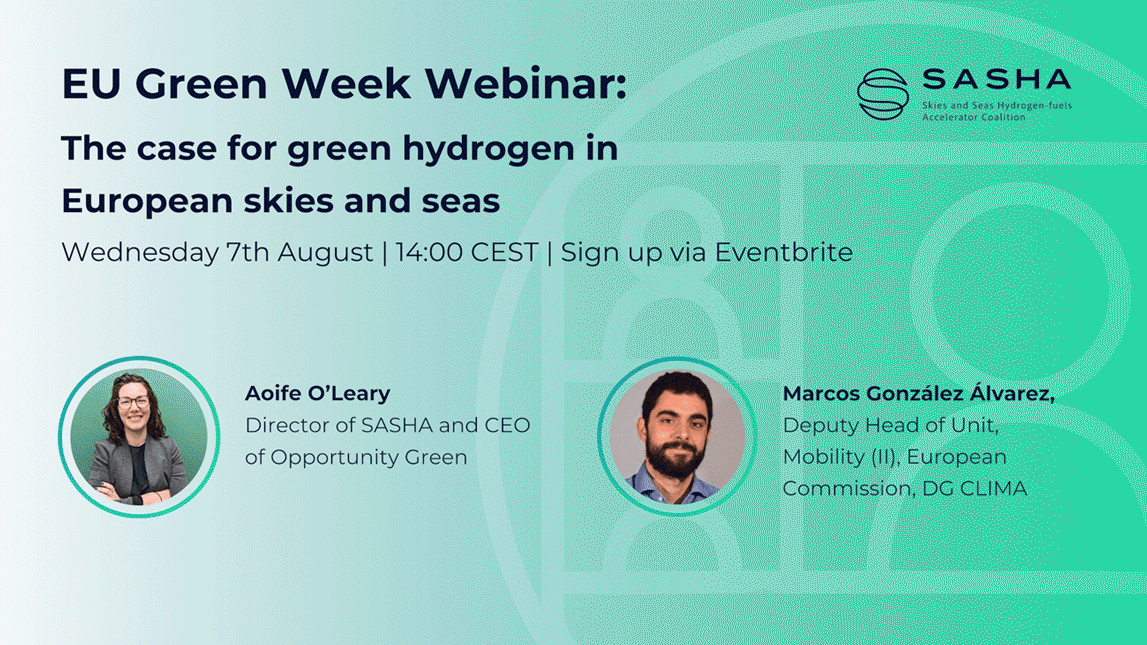The case for green hydrogen in European skies and seas
Why is green hydrogen such a crucial issue for the new EU Parliament? That was a key question at our webinar last week, where we were joined by a brilliant panel of EU industry leaders and policymakers to discuss green hydrogen's role in decarbonising aviation and shipping.
The webinar, called ‘The case for green hydrogen in European skies and seas’ looked at why the new EU Parliament needs to put green hydrogen on its agenda from day one.
Our panellists included Dominic Weeks, Head of External Affairs and Marketing at ZeroAvia, Bartek Gurba, Policy Officer of DG CLIMA of the European Commission, Oscar Felix, Commercial Manager at Future Proof Shipping and Franklin Streichenberger, Policy Manager at CO2 Value Europe. They led an exciting discussion and covered lots of ground in only an hour to give us plenty to think about.
Why green hydrogen needs stronger EU policy
Our panellists set the scene by highlighting that now there are several established companies in green hydrogen working in shipping and aviation, policy needs to see a shift towards the second half of innovation deployment – weaving green hydrogen into the shipping and aviation supply chains.
Oscar recognised that without the EU subsidies, Future Proof Shipping (and many other innovative companies) would not exist. Now that initial policy has focused on creating supply of green hydrogen, we now need the demand. He hopes that the new Commission will consider earmarking policy to help with this demand, as well as decreasing operating costs for innovators.
Representing aviation, Dominic agreed and highlighted that if we had policy that could get green hydrogen down to 6EUR per kg, that would make it competitive with conventional kerosene. This should catalyse the decrease in price of green hydrogen overall.
The need for investment in infrastructure
There was cross-panel agreement on increasing investment for the new infrastructure at ports and airports that will be needed to assist shipping and aviation in their decarbonisation.
Franklin explained that in order for the EU to successfully reach its targets by 2050, green hydrogen and its derivatives will need to represent 35% of alternative fuels for maritime and 38% for aviation. In the run up to 2030, we therefore need infrastructure elements in policy to achieve this.
Dominic highlighted that not all airports and ports are located in industrial clusters so it is difficult to tap into the green hydrogen market. This geographical problem needs to be addressed, ensuring the infrastructure is there to support the storage and transportation of green hydrogen and its derivatives.
Continuing with a more technical angle, both Oscar and Dominic identified that the most difficult challenge to overcome is volume. Although green hydrogen is great in terms of weight and energy density, it will need a lot of space on the aircraft and vessels of the future.
In ZeroAvia’s case, and for any aircraft using fuel cell technologies and carrying over 20 passengers, we need infrastructure to deal with both liquification and gasification. Oscar seconded this by explaining that however or wherever the green hydrogen is used, volume will always be an issue.
Research, development and demonstration are the way forwards
Electrification should be used where possible, especially in the context of shorter journeys and lighter loads. As green hydrogen (and fuels derived from it) is the next-best viable option due to the energy density shipping and aviation need, the EU Commission must ensure that the limited supply of green hydrogen should be allocated to industries which need them the most.
Dominic referenced how the EU’s Alliance for Zero Emission Aviation mapped that aviation will need 2.9m kg of green hydrogen per annum. This high demand profile for green hydrogen is indicative of the fact that aviation is one of the industries which desperately needs green hydrogen to decarbonise.
Franklin echoed this sentiment and explained that due to both scarcity and a high price, green hydrogen and its derivatives must go to industries which fulfil two criteria. One: they need it the most, and two: they will use it most effectively in terms of both economics and environment.
Finally, when our panellists where asked, what is the most critical policy for achieving shipping and aviation decarbonisation, they said not only R&D, but R&D&D: research, development and demonstration.
Dominic explained that the demonstration part is key – it will “bring to life and show real-world use cases” of green hydrogen. Oscar agreed and explained that consumers are also important. They can see how their fruit and vegetables get to them, so why shouldn’t we provide them with clarity on the sustainability of the supply chain when they order something online?
Bartek provided our final comments of the hour, plugging the EU’s Hydrogen Auction, and laying out the key policy priorities for the Commission in this new policy period. This ranged from including all maritime vessels in ETS reporting, matching IMO maritime targets, revising the EU ETS and providing clearer rules on low-carbon fuels and aviation allowances.
Watch the webinar in full
Here are our five key takeaways from the event:
1. Now that many innovative green hydrogen companies have been established with the crucial help of the EU’s Hydrogen Bank and the Innovation Fund, we need a policy shift towards more ambitious targets to create a new market in which these technologies can compete with conventional fossil fuels.
2. In the run up to 2030, EU policy should focus on incentivising investment in the critical infrastructure needed to support the development away from fossil fuels.
3. The biggest technological challenge to scaling up green hydrogen for use directly in these sectors is the volume requirements which can be difficult for aircraft and vessels.
4. Both shipping and aviation should electrify what they can , and with green hydrogen being the next best viable option, it’s crucial that green hydrogen and its derivatives go to the industries which need it the most, and where it will be most efficient.
5. Our panellists mentioned the importance of not just research and development, but also demonstration to showcase green hydrogen technologies and enhance both investor and consumer confidence.

